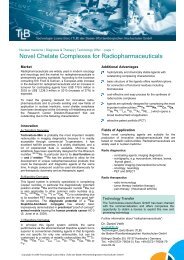Christoph Cremer and Thomas Cremer 40 years of joint ... - TLB
Christoph Cremer and Thomas Cremer 40 years of joint ... - TLB
Christoph Cremer and Thomas Cremer 40 years of joint ... - TLB
You also want an ePaper? Increase the reach of your titles
YUMPU automatically turns print PDFs into web optimized ePapers that Google loves.
<strong>Christoph</strong> <strong>Cremer</strong> <strong>and</strong> <strong>Thomas</strong> <strong>Cremer</strong><br />
<strong>40</strong> <strong>years</strong> <strong>of</strong> <strong>joint</strong> research to explore the functional nuclear<br />
architecture<br />
<strong>Christoph</strong> <strong>Cremer</strong><br />
From laser-uv-microbeam irradiation to super-resolution fluorescence<br />
Microscopy<br />
Institute <strong>of</strong> Molecular Biology (IMB), D-55128 Mainz, Germany, <strong>and</strong> Kirch h<strong>of</strong>f Institute <strong>of</strong><br />
Physics (KIP),University Heidelberg, D-69120 Heidelberg, Germany e-mail: c. cremer@imbmainz.<br />
de<br />
For about a century, far-field light microscopy suffered from the optical resolution<br />
restriction imposed by the diffraction barrier (ca. 200 nm laterally, 600 nm along the<br />
optical axis). Here, I point out our conceptual <strong>and</strong> technical contributions, which have led<br />
from the development <strong>of</strong> laser-uv-microbeams to super-resolution far field microscopy<br />
with emphasis on applications to study nuclear architecture.<br />
In a patent application filed in 1971 we (C. <strong>and</strong> T. <strong>Cremer</strong>) proposed the possibility <strong>of</strong><br />
a "HoFo" (Holographic Focusing) laser scanning microscope based on the idea that laser<br />
illumination from all sides (4π-geometry) should allow the generation <strong>of</strong> a constructive<br />
focus with a considerably smaller diameter compared to focusing with a single<br />
conventional lens.<br />
In addition to applications in super-resolution fluorescence microscopy we proposed that<br />
holographic focusing scanning microscopes might become useful for high capacity<br />
storage devices with array elements, whose optical behavior can be changed in a<br />
reversible or irreversible way by appropriate intensities <strong>and</strong> frequencies <strong>of</strong> the<br />
photoswitching electromagnetic field.<br />
Recent calculations based on electromagnetic theory <strong>and</strong> conservative assumptions<br />
indicate that constructive interference <strong>of</strong> multiple point-like light sources, spatially<br />
distributed in a "4TT" mode, should provide a 3D resolution improved by a factor <strong>of</strong><br />
~25 compared to conventional confocal microscopy.<br />
Such a resolution would correspond to values presently realized in commercial "focused<br />
nanoscopy" microscopes with the additional advantage <strong>of</strong> allowing large working<br />
distances. The ultimate theoretical limit <strong>of</strong> holographic "4TT" focusing (including novel<br />
possibilities <strong>of</strong> attosecond laser physics) deserves further consideration.<br />
Based on experience gained with the construction <strong>of</strong> a laser-uv-microbeam for 257 nm<br />
excitation (1974), we described in 1978 the first detailed construction plan for a detection<br />
pinhole based laser scanning fluorescence microscope to obtain highly<br />
resolved, threedimensional (3D) images <strong>of</strong> cellular structures.<br />
In the early 1990ies I was involved in the development <strong>of</strong> 4Pi laser microscopy based on<br />
constructive focusing <strong>of</strong> laser light through two opposing regular objective lenses.<br />
With members <strong>of</strong> my group I filed patent applications in 1996/1997 (European <strong>and</strong> USA<br />
patents granted in 2001/2002) on a procedure for superresolution microscopy by<br />
multispectral precision distance measurements (localization microscopy) in biological<br />
micro-objects.
It is based either on using fluorophores with different emission spectra or on fluorophores,<br />
which have the same emission spectrum, but different time dependent emission<br />
characteristics, such as fluorescence lifetime, luminescence <strong>and</strong> phosphorescence.<br />
Generally, such differences in "spectral signature" meant any photophysical property<br />
which can be used for optically discriminated registration. For this procedure the<br />
Abbe/Rayleigh limit <strong>of</strong> the nearest resolvable distance <strong>of</strong> two point-like targets is no<br />
longer valid.<br />
This approach has subsequently been developed <strong>and</strong> applied in my group for the 3D<br />
analysis <strong>of</strong> the molecular nanostructure <strong>of</strong> the genome in the mammalian cell nucleus.<br />
In a collaborative effort, a microscope procedure employing the time domain (in this<br />
case fluorescence lifetime <strong>of</strong> single molecules) was realized in 2002.<br />
Since the mid 1990ies, my group developed further methods to realize an enhancement<br />
in spatial resolution by spatially modulated illumination (SMI) microscopy (1997) <strong>and</strong><br />
by structured excitation illumination microscopy using a diffraction grating (1999). In a<br />
patent application filed in 2001 (3D LIMON), we described the combination <strong>of</strong> SMI<br />
microscopy <strong>and</strong> localization microscopy SPDM to analyze objects <strong>of</strong> subwavelength size,<br />
making use <strong>of</strong> r<strong>and</strong>om labeling procedures for optical object reconstruction.<br />
Based on our experience with the development <strong>of</strong> multispectral distance microscopy we<br />
built a spectral position determination (SPDMphymod) epifluorescence microscope again<br />
based on the time domain, in this case employing the blinking properties <strong>of</strong> st<strong>and</strong>ard<br />
fluorophores, such as fluorescent proteins like GFP <strong>and</strong> Alexa dyes (2008).<br />
Today, these approaches allow a manyfold improved optical resolution, our groups<br />
currently studying the nuclear topography <strong>of</strong> nucleosomes <strong>and</strong> RNA Pol II.<br />
For Reviews see:<br />
<strong>Cremer</strong> C, <strong>Cremer</strong> T (1971) 4Π Punkthologramme: Physikalische Grundlagen und mögliche<br />
Anwendungen. Enclosure to Patent application DE 2116521 „Verfahren zur Darstellung bzw. Modifikation von<br />
Objekt-Details, deren Abmessungen außerhalb der sichtbaren Wellenlängen liegen" (Procedure for the<br />
imaging <strong>and</strong> modification <strong>of</strong> object details with dimensions beyond the visible wavelengths). Filed April 5,<br />
1971; publication date October 12, 1972.Deutsches Patentamt, Berlin.<br />
Rouquette J, <strong>Cremer</strong> C, <strong>Cremer</strong> T, Fakan S (2010) Functional nuclear architecture studied by microscopy:<br />
Present <strong>and</strong> future. Int. Rev. Cel. Mol. Bio. 282: 1-156.<br />
Brunner A, Best G, Lemmer P, Ambergr R, Ach T, Dithmar S, Heintzmann R, <strong>Cremer</strong> C (2011)<br />
Fluorescence microscopy with structured excitation illumination. In: H<strong>and</strong>book <strong>of</strong> Biomedical Optics.<br />
Editors: Boas DA, Pitris C, Ramanujam N, CRC Press, Taylor <strong>and</strong> Francis Group, London, pp. 543-560.<br />
<strong>Cremer</strong> C, Kaufmann RY, Müller P, Ruckelshausen T, Lemmer P, Geiger F, Degenhard S, Wege C,<br />
Lemmermann NA, Holtappels R, Strickfaden H, Hausmann M. (2011) Superresolution imaging <strong>of</strong><br />
biological nanostructures by spectral precision distance microscopy. Biotechnol. J. 6: 1037-1051.
















